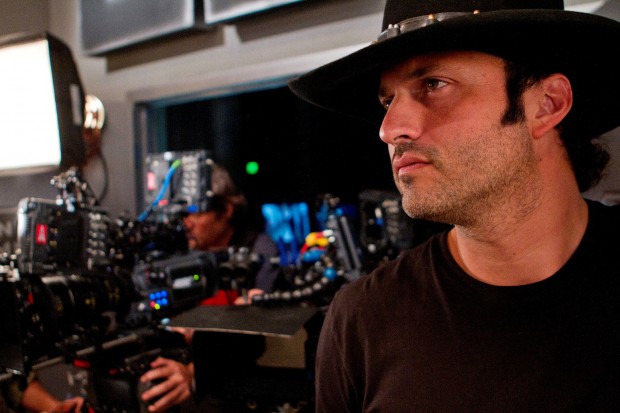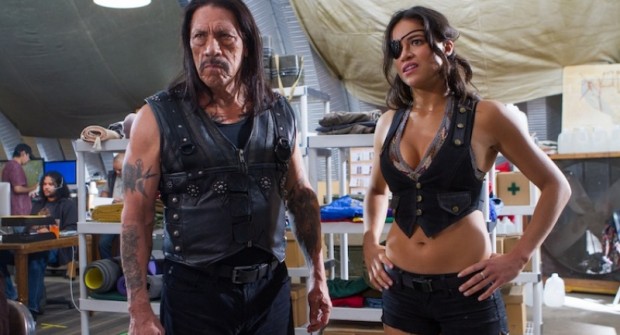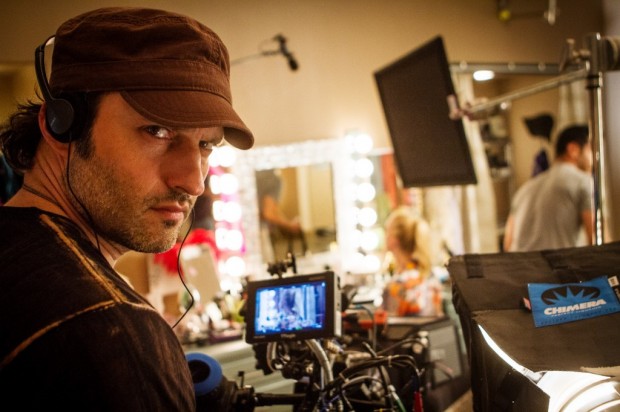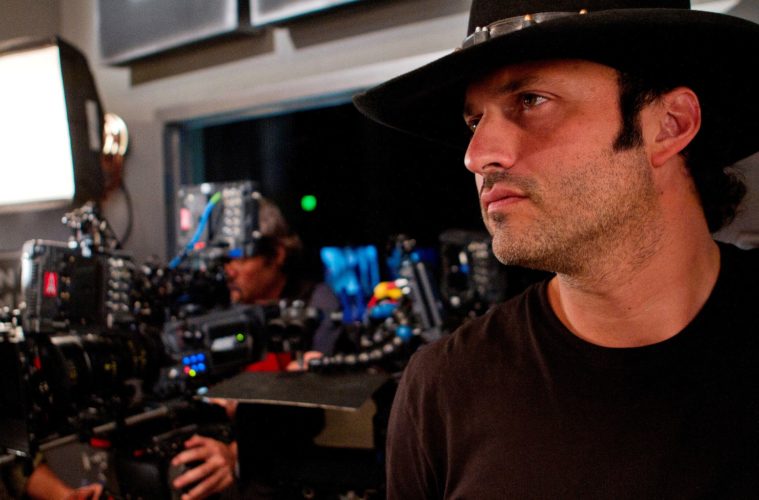
Having seen both entries in the Machete franchise there’s no doubt that writer/director Robert Rodriguez isn’t afraid to fully commit to a gimmick or joke and take it all the way. He’s back for more this weekend with Machete Kills now in wide release. Starring Danny Trejo as the heart-of-gold Federale with a penchant for creative kills, the film is all over the place and makes excellent use of its varied cast.
Last month I had the chance to sit down with Trejo and co-star Alexa Vega (check the interview here) and I also got to chat with Rodriguez. Below you can find our conversation as we discuss the pressure to come up with creative flair once he casts known actors, whether he had any throwaway ideas from the first film that he used in the sequel, why he chose a machete as a main weapon for his iconic character, the way chaps make you think you’re seeing more than you are, casting against the grain with people like George Clooney, Carla Gugino, and Vega, what he whips up for cast and crew on set, and much more.
The Film Stage: Having made a sequel, I’m curious if you took any ideas from the first that you had to give up and implemented them on the second?
Robert Rodriguez: I’m trying to think if we used anything. You know, I think we used up every idea I had in the first one.
[Both laugh]
Really?
Yeah. I hadn’t really thought there would be a sequel. I didn’t even put that title at the end of Machete until I was mixing. I was doing the final mix where Machete rides off with the girl in the end and it goes, “Machete.” But it just felt like it needed a bigger moment. That was great that he gets the girl but you want to leave on a high note. “What do I have?” So we mocked up a title that said, “Machete will return in… Machete Kills and Machete Kills Again.” I came up with it in the mixing room. But it was a joke. He’s such a legendary character that he will go on to movies we don’t even have to make. You can imagine what they’d be just by the title. But then people liked the movie and started asking for another one. [laughs] I didn’t really know where to go with it though.
Then I had this idea of Machete in space. I couldn’t get it out of my head. And I teased it at Comic-Con. “Machete will return. He will kill, and kill again IN SPACE!” People would laugh and say, “Yeah!” So I thought I’ve got to try to have my cake and eat it to if I make a sequel. Play with the idea of sequels and continuing storylines. Make it feel like it’s part of the master, mapped out plan that we’ve had. When I went forward with it I just tried to make that work.
One thing I enjoy about this series is that you seem to have a lot of fun with weapons and especially here, you give nearly everyone something unique and different. Whether it’s a weapon, a visual gimmick, or whatever. But your main character simply has a machete.
[laughs] Right. Right.
It’s just a single blade. Nothing fancy. I’m curious where the idea came from to have that and how difficult it is to come up with something new with that weapon. You have a little bit of fun with it here, but in the first it was a standard machete throughout.
Yeah. We play with it a little here because he’s more of a James Bond but it was always like, “What else can we come up with with a machete?” It’s a real creative challenge and that’s what the character constantly has to do. He has to be very resourceful. He does a lot with just his head. I mean he uses it here and there but mainly he makes a weapon out of a boat. Out of a spear gun. But instead of shooting the guy he’ll shoot a helicopter, attach the guy, and just really out there stuff. [laughs]
He may take a piece of technology and do some sort of Mexicanized tricks to it to be better. He’s kind of like a Mexican MacGyver. I thought that was his best feature was his resourcefulness. “OK, I’m in a hospital, stuck in a room, there’s a couple of small blades, a tank, and a window, and I just learned intestines are 60 feet long. [Laughs]. How do I get out of here?” That is really appealing about the character. He doesn’t rely on gadgets and having a machete means he’s pretty much got nothing.
But the knife was the original idea. Came up with the idea in ’94 and when I met Danny Trejo on Desperado in ’95. I told him about it, “You should be Machete some day. I have this character. He’s a Mexican Fédérale in the States, fish out of water [and] constantly underestimated — kind of like John Rambo. ‘Oh, he’s a vagrant. Well, he’s a day laborer.’ Instead, he’s this highly trained and specialized machine.” I tried to come up with an iconic name and I just had done El Mariachi and I though, “Oh, Machete.” Sounds like someone very sharp and to the point. And oh, that can be his weapon of choice. So that was the genesis of the character and the weapon. So it never was rethought after that.

One thing I touched on earlier was that it seems like each one of the big characters in this film has something unique about them visually. Whether it’s a gimmick or a weapon or whatever. But obviously you can’t have every single person with something unique. Is it tough to strike that balance?
You don’t want to become repetitive. You don’t want everybody just showing up with a gun. If Machete has a machete, then everybody has to be colorful. And it really depended on the cast. If I write a bunch of parts and I go to try to cast that… I tend to write a lot of characters for some reason. I think most writers probably try to consolidate a lot of them because they could easily be the same person. They’re kind of hydras. The first Machete was full of hydras. There was like five villains in that one. It was a record for me. But you have to connect them so it doesn’t feel like you have five different bad guys. But it’s really dictated by the casting. So I had a part with the madame that loses her daughter and goes on a rampage. Well, it was a very small part and I offered it to Sofia Vergara and she said yes. She’s wanted to work with me for a while. She wanted the ride. She didn’t want to just show up and say some lines. So I’m thinking, “Oh my God, I’m going to have to make her super iconic.” Her expectation is built up as much as mine and the audience’s. You have to deliver. So that’s why they get so accessorized. And that’s more of the challenge. Living up to the expectations.
So, this is the second movie where you made the assless chaps iconic.
What was the first one?
Sin City.
Oh, yeah yeah yeah! In fact, it might have been almost the same. But it’s funny about those kinds of chaps is that you’re concealing more than a bathing suit ever could but because it’s an absence of information it seems like it’s more nudity. It’s a nudity trick. I remember using a trick in Sin City where I show a little bit of nudity in the first couple of scenes. Right away. So people would think everyone’s naked the rest of the film. It takes them off-guard. And people still think Jessica Alba was naked in that movie. She never was. She was completely covered. And the chaps were there. But if you look, it’s pretty covered up. You’ve seen a lot more skin in a bathing suit.
But here, it certainly serves as a gag. We must have shot that three times throughout the film where we tried to find the best reveal and that was the best one. A sort of walkaway. It was pretty funny. Alexa had called me and wanted to do something completely different. She told me, “I’m having trouble. You kind of cursed me with Spy Kids. I’m 25 and people still think I’m that little girl. I’m getting roles for 16-year-old girls. Could you do something with me for Sin City?” And I’m like, “Wow. That would never happen. You’re just not that girl.” But I realized, “Oh, I’m kind of putting her in that box myself.” That’s probably part of the problem. I’ve had to lift that curse off George Clooney and Carla Gugino. Putting her in Sin City after doing three Spy Kids in a row. George Clooney was so good at being a nice guy on E.R. that nobody was giving him any real offers. So I cast him as a hardened killer in From Dusk Till Dawn and once people see you can do 180 degrees it opens up all the options.
Last question. Alexa was mentioning that you cook for a lot of the cast and crew on set. So what’s the go-to meal? What’s the Robert Rodriguez specialty?
It depends. There’s some really quick, healthy ones I like to make. But my favorite unhealthy one, especially when we’re shooting nights — I have a kitchen there at the studio — whenever we wrap, I’ll bring a few actors at a time. But the recipe is actually on a 10-minute cooking school video on the Sin City DVD and it’s even online. You can look it up on YouTube. It’s called “Sin City Breakfast Tacos.” I show how to make homemade flour tortillas, potato and egg tacos and migas tacos. And I have 10 minutes to show you how to do it from scratch. And it’s really good. People love that one. Late at night, too early for breakfast [and] too late for dinner. So it’s perfect.

Machete Kills is now in wide release.

